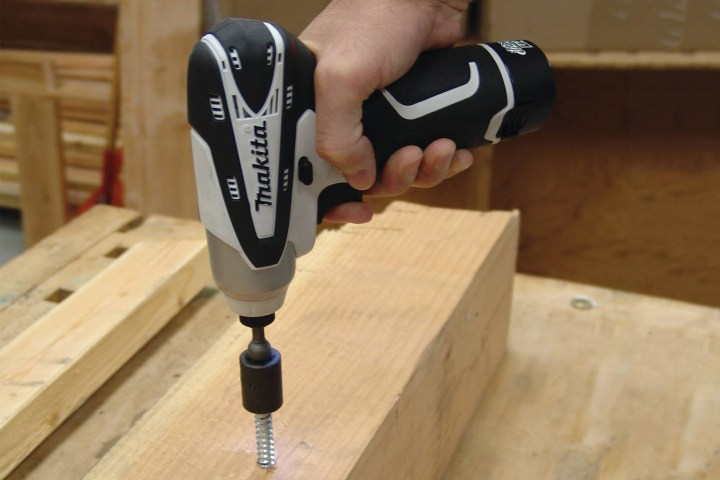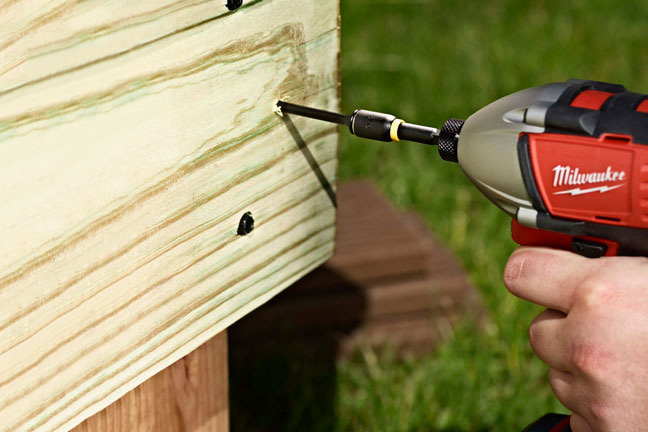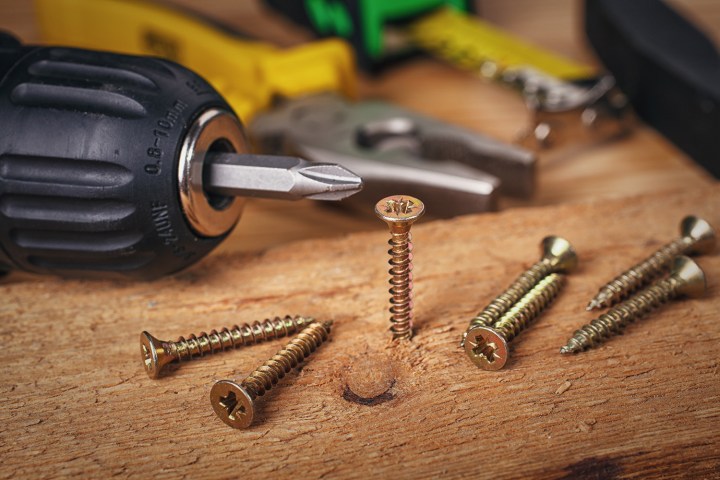Unless you like being at the mercy of grumpy landlords and pricey contractors, you’ll need a cordless drill. More accurately called drill/drivers, they not only drill holes of all sizes in any material, but drive all types of screws too. Keep the batteries charged and your little buddy will be ready to go, helping you battle a Brimnes or Björksnäs, tighten a wonky cabinet door, and power your way through serious DIY, woodworking, carpentry, and remodeling projects.
With no cord to drag around, the drill can go where ever its needed: outside to fix a fence, inside to fix a bookshelf, or in the tool bucket that travels with your trebuchet.
There are two big stories here. For one, the advent of lithium-ion batteries means you get more power and run time for less cash than ever before. But the real headline-maker is the impact driver, a new type of cordless drill that changes the game completely. The magic happens when the going gets tough, like when you are driving a long screw deep into a wall stud, for example. That’s when the drill kicks into impact mode, delivering a staccato of tiny impacts that make the screw melt into place. No torque on your wrist, no stripping screw heads. It’s just as amazing for pulling out old rusty screws too. You have to try it to believe it.
And don’t think an impact driver can’t drill, too. The impact action only kicks in in the toughest situations, and it doesn’t hurt the process a bit. It is a little loud though.
The only real downside here is price, in terms of the drill itself and the bits you need to buy, but the upside outweighs the upcharge. You’ll need to buy hex-shanked drill bits (vs. cheaper round-shanked ones), since these drills only have a quick-change chuck, but quick-change is sweet anyway, saving you from wrestling with standard drill chucks that tighten with hand power.
Our pick
20V DeWalt Max Brushless Impact Driver

Why should you buy this: No better combo of size, punch, price, and friendly features
Who’s it for: Serious remodelers, builders, and makers of all stripes
How much will it cost: $180 plus
Why we picked the 20V DeWalt Max Brushless Impact Driver (model DCF887D2):
I’ve owned a bunch of drills and tested many more, and this is my new favorite. With less friction in the drivetrain, brushless motors deliver more power from the same battery size. Add DeWalt’s excellent impact technology, and you get effortless drilling and driving in a compact tool that goes anywhere and drives like a BMW. With the battery attached below the handle, the balance is perfect and the handle will fit any hand.
Unlike some other impact drivers, the DeWalt has a speed switch. While the speed is still variable depending on how hard you squeeze the trigger, you can lower the high end, which comes in handy. Other than three LEDs surrounding the bit instead of the usual one, plus a belt hook and nice little bit holder, that’s about it. This tool just feels perfect and stops at nothing. After a few big projects, it will look like a bargain.
The best cordless drill for first-time buyers
Black & Decker 20V Max

Why should you buy this: At $50, this powerful drill is a ridiculous deal
Who’s it for: Got a blossoming interest in DIY, simple repairs, and basic remodeling projects? Trade your screwdriver for a great cordless drill
How much will it cost: $50+
Why we picked the Black & Decker 20V Max (model LDX120C):
It’s shocking how much drill you can get for $50 on Amazon. Built by the same company that makes contractor-grade DeWalt tools, the Black & Decker 20V Max boasts similar battery technology in a less heavy-duty package. It is a standard cordless drill, not an impact driver, but there is plenty of power for all but the biggest drill bits. Speaking of bits, this drill can take the less-expensive round-shanked ones, instead of the quick-change bits required by impact drivers, only adding to the value factor.
User-friendliness includes overmold rubber grips for comfort and control, and a built-in LED that sheds light in tight corners. Reviewers also point to a slender handle that fits hands of all sizes.
This price is for the drill, charger and just one battery, but you can buy it with two for uninterrupted work sessions.
The best impact driver on a budget
Makita 12 Max Cordless Impact Driver

Why should you buy this: Experience the magic of impact action for less
Who’s it for: Occasional builders, makers, and remodelers looking for a compact drill with punch
How much will it cost: $110
Why we picked the Makita 12 Max Cordless Impact Driver (model DT01W):
Impact technology has another benefit: It means you can get just as big a punch from a smaller drill. If you already have a 12-volt cordless drill, you’ll be surprised at what this impact model can do. The stick-style batteries fit up into the handle, making this little powerhouse so compact it will fit into your shop apron. It also has the requisite comfy overmold grips and and LED light for dark corners (or a flashlight in a pinch).
The 12v Makita impact driver is double the price of the bigger Black & Decker but will match it stride for stride in power and performance, in a much more compact and durable package.
The best accessory kit for impact drivers
Milwaukee Shockwave Impact Driver Bit Set

Why should you buy this: Cordless drills need drill and driver bits, and it’s hard to beat this package
Who’s it for: Owners of impact drivers, or those who want quick-change bits
How much will it cost: $35
Why we picked the Milwaukee Shockwave Impact Driver Bit Set (45-Piece; model 48-32-4009):
Your new drill won’t do a thing without the right drill bits and a variety of driver bits. Since two of the drills in this roundup are impact drivers, which require hex-shanked (quick-change) bits, and can snap wimpy ones, I went with a combo pack of essential bits that are built to take the extra torque and hammer action. The inconvenient truth about tools is you get what you pay for, and this contractor-grade set will not let you down.
It comes with the drill bits you’ll use most, all driver bits you need for all major types of screw heads (flat, Phillips, square, star, hex and more), and a bunch of invaluable accessories not found in every kit, like long driver bits for tight spaces, hex sockets for driving nuts and bolts with your magic impact action, and a magnetic bit holder that can stay in the chuck all the time, turning a standard cordless drill into a quick-change artist.
How we test
As a woodworker, remodeler, and tool tester for magazines, I’ve used scores of cordless drills, so I know what you can and should expect.
First things first, you won’t get anywhere if the chuck won’t hold bits securely. On a standard chuck, you should be able tighten it fully with out wrecking your palm or wrist. If you own an impact driver, the quick-change chuck should be just that, quick and easy to use without creating stuck bits. When I couldn’t check this myself, I looked for red flags in certified buyers’ reviews.
Next up, and probably most important, is power and run time, which are two different things. Power is indicated by a battery’s voltage and run time by its stated amp-hours, but actual performance varies between brands. Although I wasn’t able to conduct actual driving tests for the most recently introduced drills, I used past results to make bets on brands that tend to perform best.
And last there are creature comforts, like noise, vibration, balance, and comfort. Again, I went off a combination of experience, specs, and user reviews.
Helpful advice
If you are a first-time drill user, or even a longtime owner, here are a few tips you might have missed.
If you have a standard cordless drill, you’ll notice a twist-ring right behind the chuck, with numbers on it. That sets the clutch, and it is important. To avoid stripping the head of a screw, you want that setting to be the lowest that will still drive the screw home. A low setting can also help you avoid overdriving a screw, burying it in the wood or drywall. The highest setting is for drilling and the toughest driving jobs, where you want no clutch slippage at all.
There is usually also a speed switch, which you should vary for drilling (fast) and driving (slow), and don’t forget the direction switch: All drill bits must spin forward to work!
Impact drivers have a different set of quirks. Their triggers are pressure-sensitive, meaning it can be tricky to squeeze softly and maintain a slow speed. That’s why it is nice when the tool includes a speed switch that limits the top-end RPMs for driving screws or big drill bits. The impact acton is loud, so invest in a cheap set of earmuffs.




